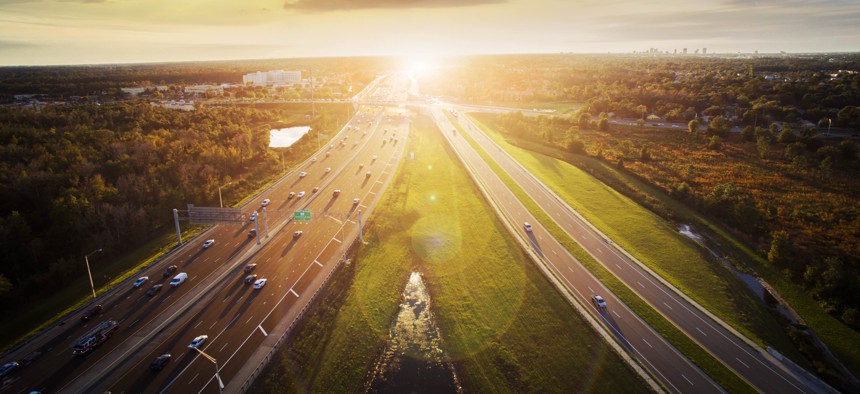Geolocation Data Could Help Planners Design Communities that Require Less Driving

Shutterstock
“By actually knowing where people are going, we can start to rethink how we plan for investments of all kinds and other policies,” says one of the authors of a new study.
Geolocation data generated from sources like cell phones, GPS devices and shared bicycle platforms promises to provide a wealth of information about where and when people are traveling that state and local planners and policy makers could incorporate into their work.
A study the Brookings Institution released this week serves as an example of the type of analysis that’s possible with this data, which offers ways to measure travel habits by trip purpose and distance. The researchers examine issues around neighborhood design and the upsides of proximity—the notion that it’s beneficial for individuals and society if people have to travel shorter distances when they make everyday trips to, say, work or the grocery store.
Adie Tomer, a fellow at Brookings' Metropolitan Policy Program and one of the authors of the study, said that when he began to look at the data he quickly realized that it “has so many planning capabilities.”
“By actually knowing where people are going, we can start to rethink how we plan for investments of all kinds and other policies,” he said. “That is really, really powerful.”
Transportation and planning practitioners, he added, are going to have to start to learn advantages and disadvantages of different types of this data and where it makes sense to make investments of their time and their agencies’ funding to acquire and work with the information.
Tomer and his co-authors look at neighborhood-level travel data for six different U.S. metropolitan areas, which cover cities including Birmingham, Alabama; Chicago; Dallas, Texas; Kansas City, Missouri; Portland, Oregon and Sacramento, California. They emphasize in the report that the trip data that they used, from the company Replica, is anonymized, or “de-identified” to protect privacy.
The researchers find that people in the six regions they examined travel over 7 miles on average for every trip they take. But distances vary widely across metro areas and neighborhoods and are under 4 miles on average in some neighborhoods that the report looks at.
The report authors are able to zoom in and look at census tracts like one in Roselle, Illinois outside of Chicago, a place they describe as “automobile-oriented,” where the median income is about $75,000 a year. The average trip from that census tract is 9 miles and often includes commutes to nearby Addison, a major suburban job hub connected by a highway.
Biking between the Roselle neighborhood and Addison, the report says, would be dangerous. Taking transit would require about triple the time it takes to do the 20 minute drive.
The report describes “human-scale” neighborhood designs leading to shorter trips.
These would be neighborhoods that are closer to core downtown areas, that have shorter blocks, that have more intersections per acre and that take up less land compared to other communities. These types of design features can often be found in older suburban neighborhoods developed before the rise of the automobile.
Tomer makes a case that when people live in closer proximity to their destinations it has benefits for both households and society at large.
People end up spending less on costs like car maintenance and gas. Governments can spend less per person on infrastructure projects like paving and widening roads. Fewer car trips can also cut emissions and lower the risk of crashes that result in roadway injuries or deaths.
“We think building for proximity has huge social benefits that we’ve been undervaluing,” Tomer said.
Instead, he argues, planners have been too focused on projects to accommodate sprawling development, and to speed-up the added car travel and congestion that comes with it. “Focusing on the distance traveled should become a priority,” he added.
But many of the development patterns now embedded across the country’s landscape, and demand among Americans for larger-sized lots and homes—even if it means more driving—don’t always mesh well with the concept of communities that allow for shorter trips.
Consider farmland on the outskirts of a city that is subdivided for larger-lot housing, and how it might result in more car trips and added infrastructure needs to accommodate extra traffic.
“What we’re suggesting is we should be thinking about how far is that new development from everything else,” including jobs, retail, and schools, Tomer said.
The ideas raised in the report tie back to longstanding, and sometimes contentious, policy issues in areas like housing affordability, racial and income inequality, transit, and the legacy of how America has built and reworked cities and suburbs over decades of time.
But the way the researchers tap into the geolocation data to provide a foundation for their analysis underscores how state and local agencies might use this type of information in similar ways to inform policy decisions and discussions surrounding these issues.
Unlike other data collection options, like surveys where small samples of people provide high levels of detail on trips, or devices that count cars at certain points on a road, the data in the report provides a fuller picture of where large numbers of people are traveling to and from.
Tomer said he has more research planned using the data, looking at travel patterns between higher and lower income neighborhoods—shedding more light on this could help inform economic development policy. “That’s the kind of stuff we can analyze now and we just couldn’t answer it before, we just did not know,” he said.
“There is a real opportunity here,” he added. “That’s part of the reason we did this work … to show what the use cases are.”
More about the analysis can be found here.
Bill Lucia is a senior reporter for Route Fifty and is based in Olympia, Washington.
NEXT STORY: How State IT Officials Ramped Up Capacity, Security As Workers Went Remote






